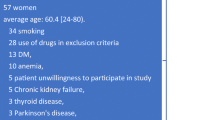Abstract
Background
The lifetime prevalence of restless legs syndrome (RLS) is about 10 % in the general population. The association of RLS with HIV infection is unknown. We aimed to investigate the prevalence of RLS in HIV positive patients and to define predictors.
Methods
A standardized questionnaire was presented to 228 HIV infected patients of the HIV outpatient clinic at the Department of Neurology,University of Münster, Germany. 129 patients (57% recall; 15% female, 44 ± 9 years; mean CD4+ cell count 333 ± 274/μl, 82% under highly active antiretroviral treatment) were included in the statistical analysis. 100 age- and sex-matched controls (20 % female, 42 ± 13 years) were recruited from waiting relatives of surgical patients. Beside demographic and disease-specific data, the questionnaire included the diagnostic questions for RLS and the RLS severity scale by the International RLS Study Group. Diagnosis of RLS was confirmed by experienced neurologists.
Results
33.3% of the HIV infected patients and 7% of the controls (p <0.001) fulfilled the diagnostic criteria for RLS. The mean RLS severity score was higher in HIV infected patients (19.5 ± 7.2) than in controls (7.3 ± 1.5; p <0.001) and correlated inversely with the CD4+ cell count (r = -.381; p = 0.024) and the BMI (r = -.548; p <0.001) but not with other disease-specific factors.
Conclusions
HIV infected patients show a significantly higher prevalence rate for RLS than the general population. The HIV infection itself with its immunological changes and involvement of the central nervous system may predispose for a risk of RLS in HIV infected patients.
Similar content being viewed by others
References
Allen R, Picchietti D, Hening W, Trenkwalder C, Walters A, Montplaisir J (2003) Restless legs syndrome: diagnostic criteria, special considerations, and epidemiology. A report from the restless legs syndrome diagnosis and epidemiology workshop at the National Institute of Health. Sleep Med 4:101-19
Allen RP, Earley CJ (2001) Restless Legs Syndrome. A review of clinical and pathophysiologic features. J Clin Neurophysiol 18:128-47
Auger C, Montplaisir J, Duquette P (2005) Increased frequency of restless legs syndrome in a French-Canadian population with multiple sclerosis. Neurology 65:1652-653
Berger K, von Eckardstein A, Trenkwalder C, Rothdach A, Junker R, Weiland SK (2002) Iron metabolism and the risk of restless legs syndrome in an elderly general population: the MEMO study. J Neurol 249:1195-199
Berger K, Luedemann J, Trenkwalder C, John U, Kessler C (2004) Sex and the risk of restless legs syndrome in the general population. Arch Intern Med 164:196-02
Cardoso F (2002) HIV-related movement disorders: epidemiology, pathogenesis and management. CNS Drugs 16:663-68
Centers for Disease Control (1993) Revised classification system for HIV infection and expanded surveillance case definition for AIDS among adults and adolescents. JAMA 269:729-30
de Mattos JP, Py MO, André C (1999) Painful legs and moving toes associated with neuropathy in HIV-infected patients. Mov Disord 14:1053-054
Gemignani F, Marbini A (2002) Restless legs syndrome and peripheral neuropathy. J Neurol Neurosurg Psychiatry 72:555
Happe S, Trenkwalder C (2004) Role of dopamine receptor agonists in the treatment of restless legs syndrome. CNS Drugs 18:27-6
Högl B, Kiechl S, Willeit J, Saletu M, Frauscher B, Seppi K, Müller J, Rungger G, Gasperi A, Wenning G, Poewe W (2005) Restless legs syndrome. A community- based study of prevalence, severity, and risk factors. Neurology 64:1920-924
Hoke A, Cornblath DR (2004) Peripheral neuropathies in human immunodeficiency virus infection. Suppl Clin Neurophysiol 57:195-10
Iannaccone S, Zucconi M, Marchettini P, Ferini-Strambi L, Nemni R, Quattrini A, Palazzi S, Lacerenza M, Formaglio F, Smirne S (1995) Evidence of peripheral axonal neuropathy in primary restless legs syndrome. Mov Disord 10:2-
Lopes LA, de Lins CM, Adeodato VG, Quental DP, de Bruin PF, Montenegro RM Jr, de Bruin VM (2005) Restless legs syndrome and quality of sleep in type 2 diabetes. Diabetes Care 28:2633-636
McArthur JC, Nance-Sproson TE, Griffin DE, Hoover D, Selnes OA, Miller EN, Margolick JB, Cohen BA, Farzadegan H, Saah A (1992) The diagnostic utility of elevation in cerebrospinal fluid beta 2-microglobulin in HIV-1 dementia. Multicenter AIDS Cohort Study. Neurology 42:1707-712
Ondo W, Jankovic J (1996) Restless legs syndrome: clinicoetiologic correlates. Neurology 47:1435-441
Phillips B, Young T, Finn L, Asher K, Hening WA, Purvis C (2000) Epidemiology of restless legs symptoms in adults. Arch Intern Med 160:2137-141
Reid S, Dwyer J (2005) Insomnia in HIV infection: a systematic review of prevalence, correlates, and management. Psychosom Med 67:260-69
Rothdach AJ, Trenkwalder C, Haberstock J, Keil U, Berger K (2000) Prevalence and risk factors of RLS in an elderly population. The MEMO study. Neurology 54:1064-068
Rutkove SB, Matheson JK, Logigian EL (1996) Restless legs syndrome in patients with polyneuropathy. Muscle Nerve 19:670-72
Salih AM, Gray RE, Mills KR, Webley M (1994) A clinical, serological and neurophysiological study of restless legs syndrome in rheumatoid arthritis. Br J Rheumatol 33:60-3
Thorpy MJ (2005) New paradigms in the treatment of restless legs syndrome. Neurology 64 (Suppl 3):S28–S33
Vosvick M, Gore-Felton C, Ashton E, Koopman C, Fluery T, Israelski D, Spiegel D (2004) Sleep disturbances among HIV-positive adults: the role of pain, stress, and social support. J Psychosom Res 57:459-63
Walters AS, LeBrocq C, Dhar A and the International Restless Legs Syndrome Study Group (2003) Validation of the International Restless Legs Syndrome Study Group rating scale for restless legs syndrome. Sleep Med 4:121-32
Winkelmann J, Wetter TC, Collado- Seidel V, Gasser T, Dichgans M, Yassouridis A, Trenkwalder C (2000) Clinical characteristics and frequency of the hereditary restless legs syndrome in a population of 300 patients. Sleep 23:597-02
Author information
Authors and Affiliations
Corresponding author
Additional information
Disclosure: The authors have reported no conflicts of interest
Rights and permissions
About this article
Cite this article
Happe, S., Kundmüller, L., Reichelt, D. et al. Comorbidity of restless legs syndrome and HIV infection. J Neurol 254, 1401–1406 (2007). https://doi.org/10.1007/s00415-007-0563-2
Received:
Revised:
Accepted:
Published:
Issue Date:
DOI: https://doi.org/10.1007/s00415-007-0563-2




